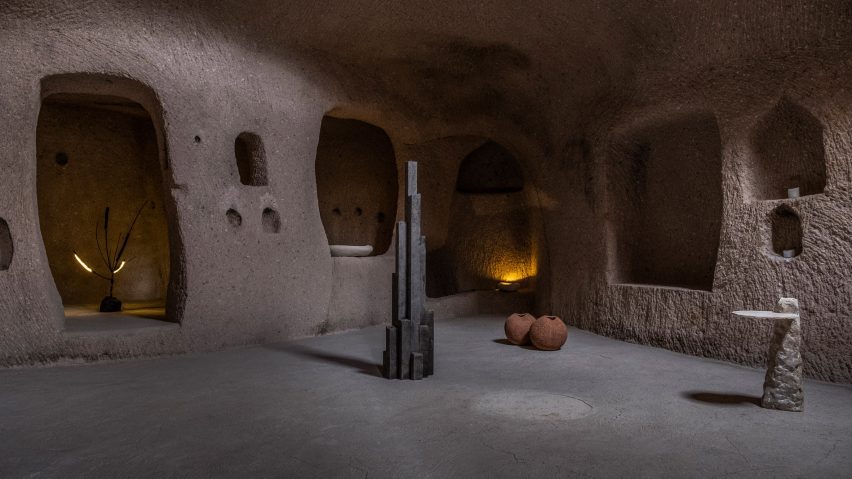The Transhumances III exhibition will see designers Andres Monnier, Morghen Studio, Elsa Foulon and Laura Pasquino present a selection of works they created in ancient cave dwellings in Cappadocia, Turkey.
The works on show, from a chandelier made out of a tree to candleholders crafted from local stone, will be showcased in a series of caves where the designers undertook their residency.
Organised by design gallery Philia, formerly known as Galerie Philia, the residency encouraged the designers to craft works inspired by the UNESCO World Heritage site in collaboration with local artisans.
Titled Transhumances III, the residency took place across 10 days in November, and was the third in a series organised by Philia that takes designers to destinations with a rich craft heritage.
"I've loved Cappadocia for a long time – it's really a region of pottery and ceramics," said Ygaël Attali, director and co-founder of Philia.
He chose the Taşkonaklar hotel in Uçhisar as the location, which operates a series of studios for artist residencies within ancient caves carved into the cliffside.
Mexican designer Monnier, known for his monumental candle holders and fire pits crafted from slabs of raw stone, worked in collaboration with local stonemasons in Cappadocia.
He made new sculptural candle holders from red onyx offcuts quarried in the region, alongside a travertine side table and black stone candelabra.
Monnier's works took inspiration from the surrounding landscape, including the unique vertical rock formations known as "fairy chimneys", and one of the mountains he passed regularly during his residency. "Cappadocia has beautiful, beautiful stones," he said.
Installed in the dark caves and topped with burning candles and incense, Monnier's works – with titles including Spiritus and Laberinto – were designed to have a ritualistic presence.
Ceramic designers Pasquino and Foulon crafted vessels and sculptural lighting respectively. As such, they both engaged in the pottery traditions of the region, working with a local potter and regional clay to translate Cappadocia's craft techniques into their own works.
Named Landforms of the Red River, Pasquino's large, spherical, hand-built vases in warm terracotta hues were made using red clay and crushed stones from a local river.
"I'm really into textures," Pasquino said, adding that she wanted the surface of her vessels to be rough, recalling both the river bed and the roughly hewn stone walls of the caves she undertook her residency in.
The Dutch designer researched the techniques and tools of local potters to learn from and apply in her work. She had never worked with terracotta before – preferring porcelain and stoneware – but since her residency, she has grown to appreciate the "powerful" effect of the material, she said.
Foulon worked with a local white clay to create a series of pebble-like table lamps, named Troglodyte Glows, that emit a warm glow from within.
The French designer was drawn to the way that light in Cappadocia "changes constantly" and impacts the colours and details of the landscape, as well as the unique quality of sunlight spilling into caves. She added a yellow underglaze in her lights to create the effect of a golden glow.
Both Foulon and Pasquino helped another of the residency's designers, Rodolfo Viola of Milan-based Morghen Studio, to work with ceramic for the first time.
The Milan-based studio creates statement sculptural lighting, mostly using brass. But to make a large-scale lighting piece in 10 days, Viola had to use a different material.
"I wanted to make a chandelier but didn't know how to go big in only a few days," he told Dezeen. "I thought it would be nice to source something from nature."
He found a tree on a local walk, charred it, and added fired ceramic "petals" covered in black ink around LED lights on its branches, attached with twine.
After creating the dramatic black chandelier in one of the caves, he installed it by hanging the tree upside-down from the cave ceiling; there, it appears almost like exposed subterranean roots.
"Having just a week to come up with something is a perfect exercise for designers," Viola said. "You don't have time to overthink. I had to learn a new material in a few days."
Together, the collection of objects are both made from and presented in the unique landscape of Cappadocia. Exhibiting them locally was vital for Attali, who wanted to avoid the carbon-heavy shipping so prevalent in the collectible design market.
Instead of importing materials and exporting works, the designers on the nomadic residency work with local materials, exhibit locally, and sell locally. "It shows that we can do things differently," said Attali.
The photography is courtesy of Maison Mouton Noir and Philia.
Transhumances III will run from 15 February to 16 March 2024 at A.R.C Taskonaklar. See Dezeen Events Guide for an up-to-date list of architecture and design events taking place around the world.

